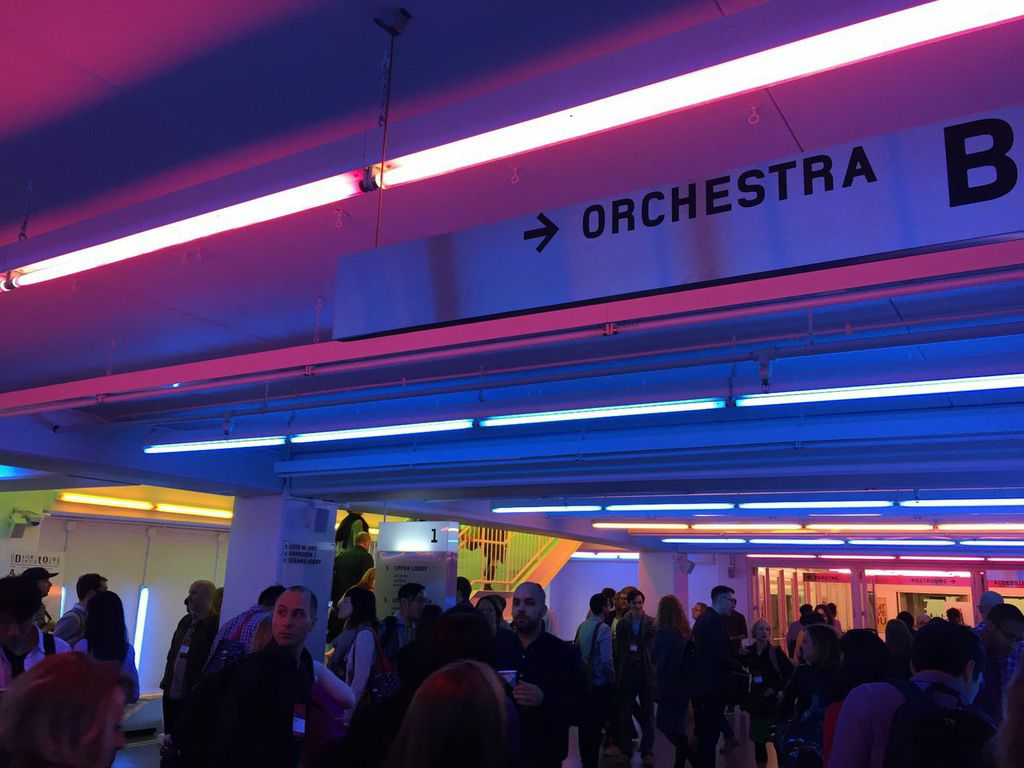Just over a week ago, I attended Under Consideration’s fifth annual Brand New Conference in Chicago. Before I get into the details, I want to give a huge congrats to Armin Vit and Bryony Gomez-Palacio. Not only have they been sustaining a stellar design series in Austin, they simultaneously lined up an unforgettable two days packed with some serious branding chops. Pulling off a huge design event in the midst of a million other conferences is no easy task.
The identity for the event itself was incredibly thoughtful, combining the dichotomy of a retired Mac OS font, trendy wiggles, Chicago’s grid system, and questionable winter fashion as an ode to the hosting city. A beautifully documented process included video clips of how Bryony and the volunteers assembled more than 700 badges and a bunch of fiberglass letters for the stage—by hand. Serious dedication to the cause, and that was only the beginning.
Each subsequent presentation provided context, unique to the speakers’ experiences and expertise, in which branding continues to shift and expand. An identity is best served and utilized when those who are responsible for its lifecycle apply it efficiently to every facet of the user’s experience. Designers, directors and content creators discussed the purpose of their respective processes, both on and off the screen.
Lance Wyman has a presence like no other. The man behind the Olympics logo has a powerful talent for simplicity and iconographic finesse. He shared the insight of half a century of timeless work from wayfinding systems, including the Washington DC metro map and National Zoo signage. “Learn to speak to non-designers about design. It will help your career.” Wyman advised us to avoid confining our craft to a definition, but rather tell people what it can do for them.
“The logo is the most important thing.” “No, the system is the most important thing.” Bobby Martin and Jennifer Kinon from OCD delivered an entertaining and informative two-part speech, refuting each others claims with validated discussion. They showed us one of their “brand architecture” charts and talked about how to “provide inspiration, not rules.” Jennifer presented their rebrand of Girl Scouts of America and how the system they developed enabled troops around the country to make the identity their own while staying on brand. “Understand the business and make everyone’s lives easier.” Clients have a goal to reach, and the more we understand those goals, the more successful our solutions will be.
Location can be a huge defining factor for an agency. Not Anagrama. They’ve proven that a remote environment doesn’t prohibit you from building a great company and finding your audience. When they walk outside their studio, Sebastian Padilla and his team are faced with the drab, industrial haze of Monterrey (the capital and largest city of Nuevo León in Mexico). They’ve found incredible success in creating systems for luxury brands, appealing to “the rich housewives” who shop online at home all day. Genius. I should also mention their brainchild, ZED: a CRM/project management tool that uses algorithms inspired by airlines to accurately measure budget and billings, team bandwidth, timelines and more. Definitely something to keep an eye out for, should they decide to release the software in the future.
“Pick people over projects.” It’s not easy to turn something down when it has a nicely-sized budget, but Jeff Perky (Perky Bros) went into an insightful discussion about taking risks when you’re broke and how good work for good people turns into more good work for good people. “If it needs to be done, change your circumstance.” He talked about design work and the goal to “make it human,” a notion echoed later on by Eli Altman of A Hundred Monkeys. They run their business by giving other businesses a name, which is a lot harder than it may seem. “Who wants to go on an airline that says ‘we haven’t done this before?” In naming, it’s important to do three things:
- Use a real word. There are plenty of them out there, so why make up one that has no human connection or meaning?
- Make sure your name doesn’t mean “pig sodomist” in Korean.
- They once named a company “Cruel World.” It was a job search site. Learn to understand the end user and their mindset upon interacting with the name. Give the audience something to start a conversation about, not something to be confused by, so they can interact in a meaningful and memorable way.
“The process of design should not always (always necessarily) be about authorship.” Armin introduced Keira Alexandra of Work-Order as the “industry’s best-kept secret.” Jeff Perky had mentioned the egos of designers versus the egos of clients, and Keira brought that straight home by reminding us not to create solutions for others in vein. It’s common for designers to slip into designing for other designers — even when it’s not the best way to meet a client or user’s needs. When you’re solving their problem, it’s not always about you. We love our profession so much that we want to make everything ours, but we shouldn’t forfeit our ability to educate others by showing them how great branding can elevate the integrity of their goals.
Brand New Conference reframes fundamental concepts into relevant conversations. Every project is a branding project, whether it’s for you, your client or the users you’ll never meet. Designers combine skill, research and the understanding of the business to “show them what they want to be.” Snappy interactions reflect the brand. Content and tone reflect the brand. If deeper structural issues are veiled by a “rebrand,” the way in which those problems are solved (or not) reflects the brand. Brilliant logos have impact and might be the most tangible entry point to a company’s identity, but it takes a village—the system is the most important thing.
You can find the full list of speakers here. Videos of the Brand New Conference presentations will be available online in the upcoming weeks. See what Twitter had to say about it, and check out more of our posts and case studies on Sketchbook.

